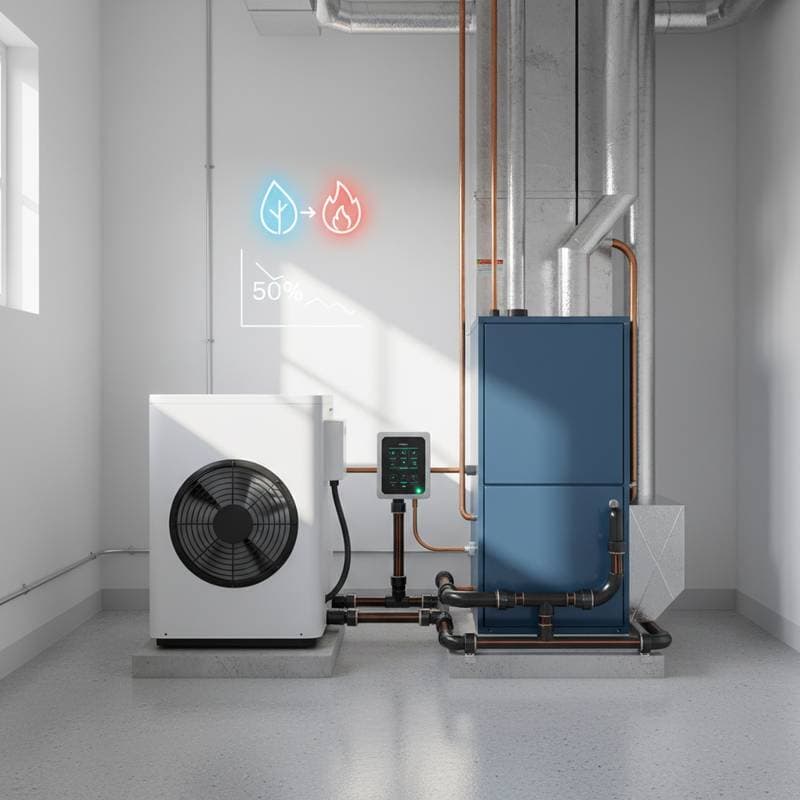Dual-Fuel HVAC: Reduce Winter Heating Bills by 50 Percent in 2025
Homeowners often face rising heating expenses during winter months. Traditional systems struggle with temperature variations, leading to inefficiency and discomfort. A dual-fuel HVAC system addresses these issues by integrating an electric heat pump with a gas furnace. This hybrid approach switches automatically to optimize efficiency, comfort, and cost savings.
Understanding the Winter Heating Challenge
Winter weather in many areas features abrupt shifts from mild conditions to severe cold. Conventional gas furnaces provide reliable heat but consume substantial fuel during extreme lows. Electric heat pumps excel in moderate temperatures by extracting outdoor air heat but falter in subfreezing conditions. Homeowners frequently incur hundreds of dollars in extra costs annually due to these limitations.
Dual-fuel systems, also known as hybrid heating solutions, offer a practical remedy. Industry energy analyses indicate that properly configured dual-fuel setups can reduce winter heating expenses by 40 to 50 percent relative to legacy systems. These savings stem from intelligent fuel selection based on real-time weather demands.
Mechanics of Dual-Fuel HVAC Operation
A dual-fuel HVAC system operates like a coordinated partnership between components. The electric heat pump serves as the primary source during milder weather, efficiently moving heat from outside to inside the home. When outdoor temperatures fall below an efficient threshold, typically around 30 degrees Fahrenheit, the gas furnace activates automatically.
A central control board oversees this transition by sensing ambient conditions and indoor needs. This ensures the system always employs the most cost-effective and performant heating method. As a result, users benefit from consistent warmth without excessive energy consumption.
Financial Advantages of Hybrid Heating
HVAC professionals frequently advise dual-fuel installations for those seeking stable utility expenses. Electricity prices tend to fluctuate less than natural gas rates, providing inherent flexibility. The system's ability to alternate fuels allows it to favor the lower-cost option during price surges.
Key benefits include:
- Reduced monthly bills: Reports from users show 30 to 50 percent savings across an entire heating season.
- Extended equipment durability: Lighter workloads on individual components minimize wear and extend service life.
- Enhanced indoor comfort: Heat pumps distribute even temperatures, with the furnace ensuring reliability during peak cold.
Steps to Optimize Dual-Fuel System Performance
Proper installation and maintenance are essential for realizing a dual-fuel system's potential. Follow these targeted actions to achieve optimal results.
-
Conduct a professional load calculation. Use a Manual J assessment to match system capacity precisely to the home's heating and cooling requirements. This prevents energy loss from mismatched sizing.
-
Verify thermostat integration. Select a smart thermostat compatible with dual-fuel operation to automate switch points. Such devices adjust based on efficiency data, eliminating the need for manual intervention.
-
Inspect and seal ductwork. Leaks in ducts can dissipate up to 30 percent of heated air. Apply mastic sealant and add insulation to vulnerable sections for immediate efficiency gains.
-
Arrange annual professional servicing. Routine checks on the heat pump and furnace can enhance performance by 10 to 15 percent. Technicians verify refrigerant charges, combustion efficiency, and component cleanliness.
-
Track energy consumption patterns. Leverage built-in system apps to monitor usage in real time. Adjust thermostat schedules accordingly to target peak savings periods.
Essential Factors for Dual-Fuel Installation
Prospective installers should evaluate several practical aspects before proceeding.
Installation expenses range from $6,000 to $12,000, influenced by home dimensions, efficiency specifications, and selected brands. Most owners recover this investment in five to seven years via reduced energy outlays. Local building codes may mandate permits for gas connections; certified technicians manage these requirements to ensure safety and adherence.
Utility providers often provide rebates for efficient hybrid systems, offsetting initial costs by several hundred dollars. John Sanborn, a certified HVAC technician based in Colorado, notes, "Dual-fuel systems combine the strengths of electric and gas heating. They deliver control over comfort and expenses without compromising dependability."
Strategies for Year-Round Dual-Fuel Efficiency
Implement these proven techniques to sustain high performance throughout the seasons.
Fine-tune the balance point, the outdoor temperature triggering the furnace switch, in consultation with an HVAC specialist. This adjustment can yield an additional 5 percent in efficiency. Replace air filters every month to preserve airflow and lessen operational stress on both units.
Clear snow, leaves, and debris from the outdoor heat pump unit regularly to safeguard airflow. Before each heating season, test the thermostat to confirm accurate activation of both heating modes and communication with the control system.
Implementing Your Dual-Fuel Upgrade
Transitioning to a dual-fuel HVAC system positions homeowners for substantial winter savings and reliable comfort. The seamless integration of heat pump and furnace technologies minimizes temperature inconsistencies and utility demands. Contact a licensed HVAC professional for an assessment tailored to your property.
This upgrade represents a strategic enhancement to home heating infrastructure. It promotes sustained efficiency, durability, and enjoyment during colder months.
Frequently Asked Questions
**How frequently does a dual-fuel system require servicing?**Plan for maintenance twice annually, prior to cooling and heating seasons. Each session typically costs $100 to $200 and averts up to 80 percent of possible failures.



